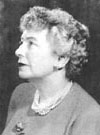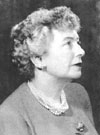About Elvenia J Slosson

She was born in San Francisco; married a very successful lawyer, Leonard B. Slosson; and they made their home in Los Angeles.
Elvenia had her own inherited wealth, the Casper Lumber Company in Mendocino County, south of Ft. Bragg. She was a young woman when her son, Paul, was born severely handicapped. Even though she had nurses around the clock to care for Paul, she was a recluse for eighteen years. She became a devout Christian Scientist and was very serious in her religious beliefs. During this sad and trying period, Elvenia spent much time in a beautiful, walled garden in the rear of her home, where the nurses could take Paul and where her absorbing interest in gardening was nurtured.
"Garden Club organization progressed well through the dynamic force of this woman with a charmingly soft voice, fire in her eye and determination in her purpose. She had a sensible outlook and the cleverness to couple power with persuasion." (Mrs. Maria Wilkes, "We Were There, 1933-1973")
It was shortly after Paul's death that Mrs. Slosson started the organization of the California Garden Club Federation. Although she was an active member of the Wilshire Garden Club, she was ill-prepared for public life and working with women. This often caused some complications, but it never diverted her from her objective, a strong California Garden Club.
She traveled tirelessly during the early depression years, talking to garden clubs and encouraging them to join the state organization. Her younger companion, adoring friend and driver during these early days was Rosamund Bacon, of Stanford, who furnished most of this early information.
During their travels Mrs. Slosson met nurserymen and women horticulturists throughout the state. She made close friendships with Charlotte Hoak in Los Angeles, Kate Sessions in San Diego, and Alice Eastman in San Francisco. Rosamund Bacon states that "right from the start she sought out experts in the horticulture field and gained great satisfaction from the hours spent with them."
There were several horticultural researchers at Berkeley and at the University of California at Los Angeles to whom she often turned for advice and later, for articles for Golden Gardens. One was Mr. H. M. Butterfield, who became active in the fledgling garden club movement. Even before joining National Council, "Golden Gardens," the state publication, made its appearance.
Mrs. Slosson was very creative, with a great amount of talent for writing and editing; and during the early years she was the mainstay of the magazine. Charlotte Hoak was the editor; Rosamund Bacon did the chores of getting out the magazine; but Elvenia Slosson was the creative source.
At the organizational meeting of the California Garden Club Federation in Santa Maria, December 5, 1931, Mrs. Slosson was elected president of the twenty-three clubs. The object, not too much altered in the intervening fifty years, "shall be to promote interest of the amateur gardener in flowers and in his own garden, which naturally leads to an interest on his part in the beautification of his own community and finally in that of his state, the latter interest becoming an influence for the benefit to all, through force of numbers; and to assist in movements for conserving and enhancing the natural beauty of our state."
At the First Annual meeting, April 23, 1931, the President told of her dream of united clubs, of her vision of helping hands, and of an out-of-doors guarded and beautiful. She spoke of better flower shows and the need of knowing how to judge them, and of the strength and growth there is in union.
In 1932 the first State Yearbook was compiled by Mrs. Slosson; and on December 5, 1932, the California Garden Club Federation was admitted to membership in National Council of State Garden Clubs, Inc. Mrs. Slosson personally wrote a Procedure Book for the first officers and chairmen. The State Library was started, seeds of rare plants were distributed to clubs, and garden centers and junior gardening were started in the state.
During her presidency, Mrs. Slosson was not only Managing Editor of Golden Gardens, but she compiled and edited the "Flower Show Judging Pamphlet." In April 11-14, 1935, National Council held its Sixth Annual Meeting at the Los Angeles Ambassador Hotel, hosted by California Garden Clubs, with Elvenia Slosson as President.
Elvenia served as California president four years, in the middle of which, in 1933, she became the founding vice president of Pacific Coast Region. There the Regional speaker's bureau was born and a set of native tree slides of Pacific Region states was compiled. Oregon was re-admitted to National Council and Arizona joined in 1935. With Washington and California, this amounted to four Pacific Coast Region states, with Idaho planning to join the next year.
Her term as vice president lasted until 1937. During the years 1941-1943 she was appointed to the National Executive Committee as a member-at-large. This was marred by the illness of her husband, and she devoted her time caring for him until his death in 1947. That year she organized the Bulb Society and was appointed National Parliamentarian for Mrs. Lewis M. Hull, National Council President.
In 1949, Elvenia Slosson was elected the tenth National President at the convention in Portland, Oregon. She reactivated Regional Meetings in the forty-two federated states and revived the Council of State Presidents which she had launched in 1935. Stories were collected from the various state federations and she compiled "Pioneer American Gardening," now out- of-print.
National Affiliates were started in 1950 when the Men's Garden Club of America became the first member. Following her interest in youth, the "Elvenia J. Slosson Junior Garden Club Achievement Award" was given annually until 1956, when it was revised to reappear in 1961 as the current National Award #14.
As president, she lived part of the time in New York to be near the National office and her attorney; in this way, through her management and loyalty, she was able to keep National Council out of a serious lawsuit. Through her efforts the position of National Council was greatly strengthened and the balance left in the National treasury when her term concluded was $20,000. This information was derived from Mrs. John B. Simmons, who was Elvenia's confidante and National Membership Chairman during her presidency.
At the California Garden Clubs, Inc. convention at Coronado in 1958, the assembly voted to place a sofa in the new National Home in her honor. This pleased her immensely as she went off to the east coast for installation duties and visiting friends. She became ill and died on October 22, 1958.
In 1965, California Garden Clubs had her name placed on the wall at the National Permanent Home as a "Steward of Tomorrow." As she chose those as helpers who would work together for a common cause and would be loyal to the purpose, Elvenia J. Slosson's name will stand high as the first person to have thought of, and carried out, the colossal work of organizing this great state.
Under the terms of her will, she left the residue of her estate, about one million dollars, in trust, the income going to five relatives for life and the remainder to the Board of Regents of the University of California, The trust terminated with the death of Stuart Slosson on September 16, 1969. The estate then went to the University to be used for arboretums, beautifying highways, supporting plant expeditions for ornamental plants, encouraging local garden clubs, and encouraging publications relating to the history of gardening and current articles on ornamental horticulture, all oriented toward research.
In 1972, the "Elvenia J. Slosson Grant" was made to Toshio Murashige for $229,183, this to cover a five-year period for "plant cell tissues and organ culture studies in ornamental and other plants." This research gave rise to the "green revolution" in the early 1970's when plants appeared in every home, in nursery, grocery and department stores, and in many other places.
In 1975, a committee was established to make suggestions as to how the fund should be used. It was agreed that the use of the funds be for high quality, research oriented, ornamental horticulture for the home garden. The Fund should receive recognition, with result; published in a form for the general public, using amateur garden journals such as Golden Gardens, as well as professional journals. The Fund also was not to support overhead budget, but would provide public service functions, lectures, forums and special publications.
Grants have been given to many diverse projects including University campus arboretums, developing new plant varieties, entomology, fertilizers, elm and oak tree problems, publications, books, pamphlets, and slide and TV programs. In 1981, some of the specific projects were the biology and ecology of leaf miner on chrysanthemums; solarization of soil for non-pesticide pest control; biological control of white fly; studies of Mojave desert shrubs; control of frost injury; development of succulent plants for Southern California; Lester Rowntree documentary conclusion; and two projects with which California Garden Clubs is familiar, Tom Brown's "History of California Victorian Gardens" and the UCLA Landscape Design Study Course. The Fund is constantly generating new revenue, and will be alive and well for years to come, a noble memorial to Elvenia J. Slosson, Founding President of California Garden Clubs, Inc.
Mrs. Wallace F. Hirsch, Past President California Garden Clubs, Inc.
(This was excerpted from the California Garden Clubs’ 1982 publication entitled “The Golden Years”.)
12/3/99

